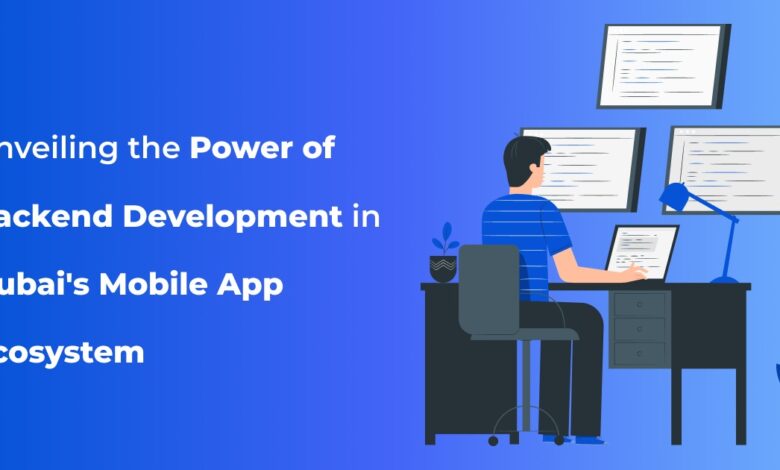Unveiling the Power of Backend Development in Dubai’s Mobile App Ecosystem

With the rapid surge in mobile app usage, the focus now transcends merely creating an outstanding app to understanding the core components that differentiate an exceptional app from an average one.
In the realm of a seamless user experience, the discussion remains incomplete without acknowledging the paramount role of an efficient mobile app backend architecture. This article serves as a guiding beacon, unraveling the significance of backend development, exploring essential software stacks used for backend architecture, and identifying tools that bolster the creation of a robust backend process.
Let’s start by delineating the differentiation between frontend and backend server development for mobile apps.
Table of Contents
Frontend VS Backend Development
When delving into the distinction between frontend and backend development, the standard explanation often revolves around the frontend working on an app’s visual appeal while the backend handles the app’s functionality.
Frontend applications constitute those installed from the Play Store or App Store on your smartphone. Apps like Instagram, Facebook, or Calculator are perfect examples of frontend mobile applications, enabling direct interaction through buttons, text fields, and other mobile-specific features.
A frontend developer’s responsibility is translating the app’s design into code for proper display across various browsers and mobile platforms.
Understanding Backend Development
To put it simply, consider the backend as an additional layer supporting a mobile application. It’s a piece of software that operates on servers and encompasses servers, databases, middleware, and more, accessible through the internet via an Application Programming Interface (API).
Backend developers ensure the connection between the visible app content and the CMS, crafting the logic necessary for seamless functioning. They need to strike a balance in backend architecture, offering both simplicity and comprehensiveness to enable user control without compromising the app’s design.
Now, let’s dive into the functionalities requiring backend development in mobile apps.
Mobile Application Functions Requiring Backend Development
Several crucial aspects are crucial for an effective mobile app backend:
Cloud Server:
These servers, available in various sizes and securely stored, are increasingly accessible. The adoption of well-known cloud servers like Google App Engine, Microsoft Azure, and Amazon AWS is prevalent, especially among large enterprises due to their reliability, scalability, and secure infrastructure. These cloud platforms offer diverse storage options, robust security features, and extensive computing resources.
Software-as-a-Service (SaaS) or 3rd Party Services:
Many pre-existing services offer functionalities specifically designed for frontend applications, simplifying development needs. These ready-to-use services are tailored to seamlessly integrate with frontend apps, streamlining the development process and enabling swift implementation of essential features. Users can subscribe to these services, acquiring a fully functional backend with minimal effort.
Mobile Backend as a Service (MBaaS):
MBaaS providers offer robust functionalities and analytics for app monitoring, catering to those bypassing backend server creation or cloud investments. These services streamline backend needs without extensive infrastructure, making app management efficient and cost-effective.
Custom Server:
Considered the most adaptable and powerful choice, catering to specific app demands and configurations. Nevertheless, the setup cost demands specialized backend skills and entails a significant financial consideration.
Understanding Backend Architecture and Mobile App Server Operations
Custom backend development is deeply intertwined with core components defining a server’s software stack.
The backend’s technology stack simplifies into four components: the database, server, software, and operating system.
Servers, whether on-site or in the cloud, provide shared resources essential for the network’s operation, including encryption, file storage, email, databases, and web services.
Databases form the dynamic core of an application, handling user requests, data retrieval, and management.
Middleware acts as the connectivity bridge between an application’s frontend and backend, enabling user-server interaction and offering various business and presentation layers.
Moving forward, let’s discuss the best tools powering backend development for mobile apps. These widely used tools have been instrumental across various projects of different scales.
Tools for Applications and Web Backend Development
Web Server Tools:
NGINX: An open-source software used for various functions from web serving to load balancing and media streaming.
Apache: A highly reliable software embraced by over 50.1% of global apps in the web server industry.
Database Tools:
MySQL: A scalable, free, and easy-to-set-up relational database, trusted for diverse database requirements.
MongoDB: A free open-source NoSQL database system using a binary JSON format for efficient data exchange.
Git Clients:
SourceTree: Simplifies interactions with Mercurial and Git repositories, streamlining repository management.
GitHub Client: Empowers developers with a unified cross-platform coding experience using HTML, CSS, and JavaScript.
Microservice Platform Tools:
Kubernetes: An open-source platform managing container clusters, facilitating automated deployment and scaling of application containers across diverse hosts.
Docker: Streamlines microservices by offering tools for packaging, deployment, and distribution of compartmentalized apps.
Local Development Environment:
WampServer: A development environment allowing web application creation using PHP, Apache, and MySQL, packaged with SQLite and PhpMyAdmin for database management.
XAMPP: Integrates Apache, PHP, Perl, and MariaDB, simplifying the setup of a web server solution stack.
Collaboration Service Tools:
Slack: A cloud-based collaboration and messaging app revolutionizing enterprise communication and workflow efficiency.
Jira: A web-based project management tool employing Scrum and Kanban methodologies for project management.
App Performance Test Tools:
Apache JMeter: Tests an app’s performance and speed under diverse conditions, originally designed for web apps but now also catering to app performance testing.
AppLoader: Facilitates comprehensive testing of the complete business flow without the need for additional plugins or coding.
Advantages of Backend Development
Backend development contributes significantly to all stages of the app development process, offering several key advantages:
- Accelerated development speed
- Cost-efficiency
- Focus on core business aspects
- Improved productivity in less time
- Reduced time to market
- Expanded app feature set
- Outsourcing cloud infrastructure
- Continuous delivery and integration
- Optimized performance and security
- Compliance with privacy regulations like GDPR
Concluding Thoughts
To conclude, APIs are essential in backend development, serving as the linchpin connecting applications, software, databases, and services seamlessly.
How Mobile App Development in Dubai Can Benefit from Backend Expertise?
In the burgeoning marketplace of mobile app development in Dubai, a robust backend is pivotal. By leveraging the expertise of skilled developers, one can tailor solutions catering to the specific requirements and expectations of Dubai’s mobile app ecosystem. Skilled professionals versed in backend development can effectively shape apps to suit the demands of this diverse and competitive market.
Whether crafting applications for local services, tourism, finance, or commerce, understanding the backend’s influence becomes crucial for a seamless and effective mobile app experience. Collaborating with proficient developers versed in the dynamics of Dubai’s marketplace will undoubtedly contribute to the success of mobile apps within this landscape.
For your mobile apps to excel in Dubai’s bustling market, the support and skill of seasoned mobile app developers in Dubai are vital. Their expertise in backend development tailored for the Dubai market ensures your app meets diverse user needs, delivering innovative, optimized solutions.


